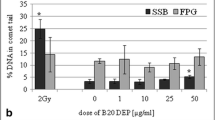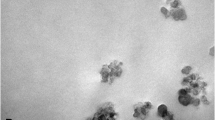Abstract.
Diesel engine exhaust particles (DEP) contribute substantially to ambient air pollution. They cause acute and chronic adverse health effects in humans. Biodiesel (rapeseed oil methyl ester, RME) is used as a "green fuel" in several countries. For a preliminary assessment of environmental and health effects of RME, the particulate-associated emissions from the DEP of RME and common fossil diesel fuel (DF) and their in vitro cytotoxic and mutagenic effects were compared. A test tractor was fuelled with RME and DF and driven in a European standard test cycle (ECE R49) on an engine dynamometer. Particle numbers and size distributions of the exhausts were determined at the load modes "idling" and "rated power". Filter-sampled particles were extracted and their cytotoxic properties tested using the neutral red assay. Mutagenicity was tested using the Salmonella typhimurium/microsome assay. Despite higher total particle emissions, solid particulate matter (soot) in the emissions from RME was lower than in the emissions from DF. While the size distributions and the numbers of emitted particles at "rated power" were nearly identical for the two fuels, at "idling" DF emitted substantially higher numbers of smaller particles than RME. The RME extracts caused fourfold stronger toxic effects on mouse fibroblasts at "idling" but not at "rated power" than DF extracts. The extracts at both load modes were significantly mutagenic in TA98 and TA100. However, extracts of DF showed a fourfold higher mutagenic effect in TA98 (and twofold in TA100) than extracts of RME. These results indicate benefits as well as disadvantages for humans and the environment from the use of RME as a fuel for tractors. The lower mutagenic potency of DEP from RME compared to DEP from DF is probably due to lower emissions of polycyclic aromatic compounds. The higher toxicity is probably caused by carbonyl compounds and unburned fuel, and reduces the benefits of the lower emissions of solid particulate matter and mutagens from RME.
Similar content being viewed by others
Author information
Authors and Affiliations
Additional information
Electronic Publication
Rights and permissions
About this article
Cite this article
Bünger, J., Krahl, J., Baum, K. et al. Cytotoxic and mutagenic effects, particle size and concentration analysis of diesel engine emissions using biodiesel and petrol diesel as fuel. Arch Toxicol 74, 490–498 (2000). https://doi.org/10.1007/s002040000155
Received:
Accepted:
Issue Date:
DOI: https://doi.org/10.1007/s002040000155




